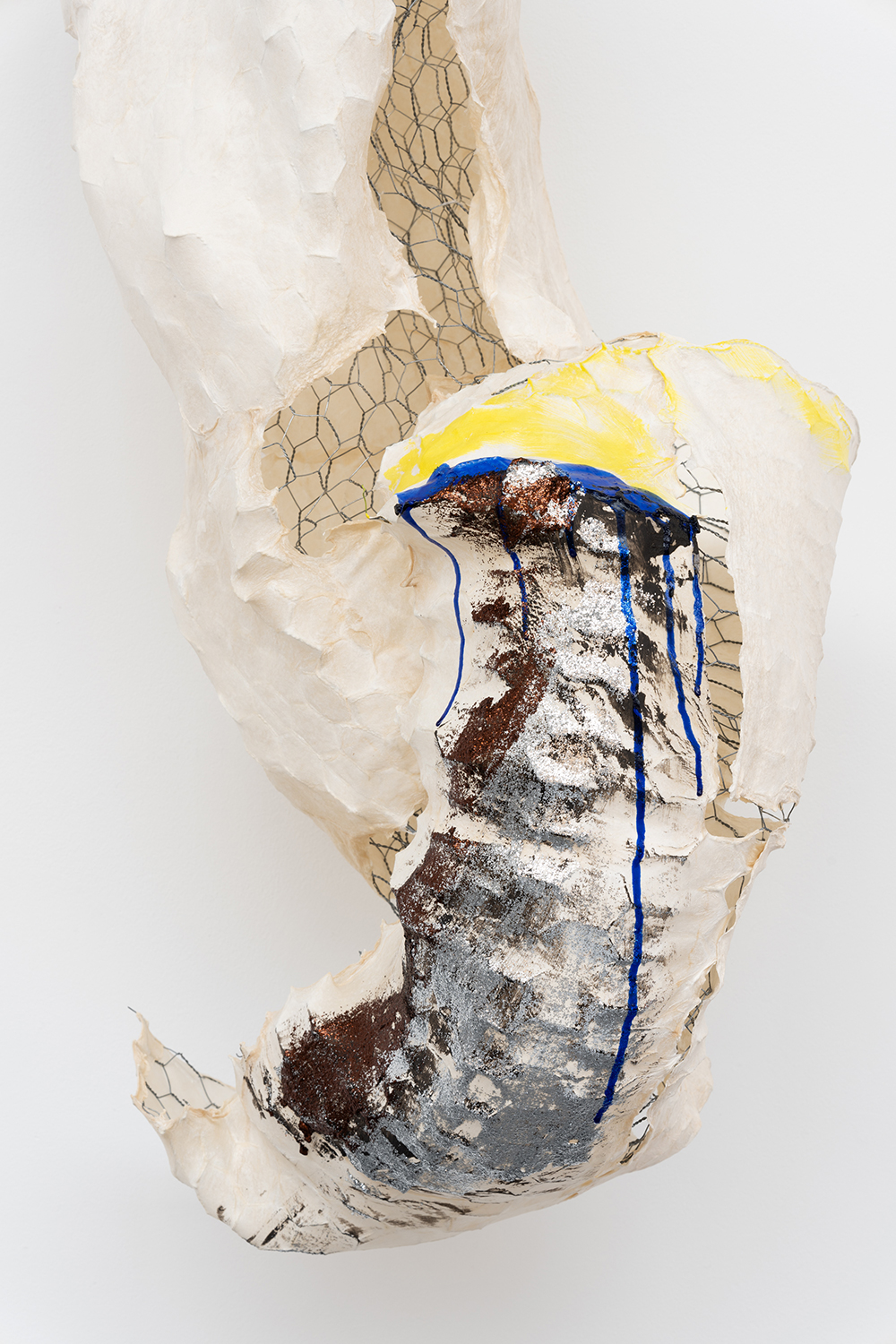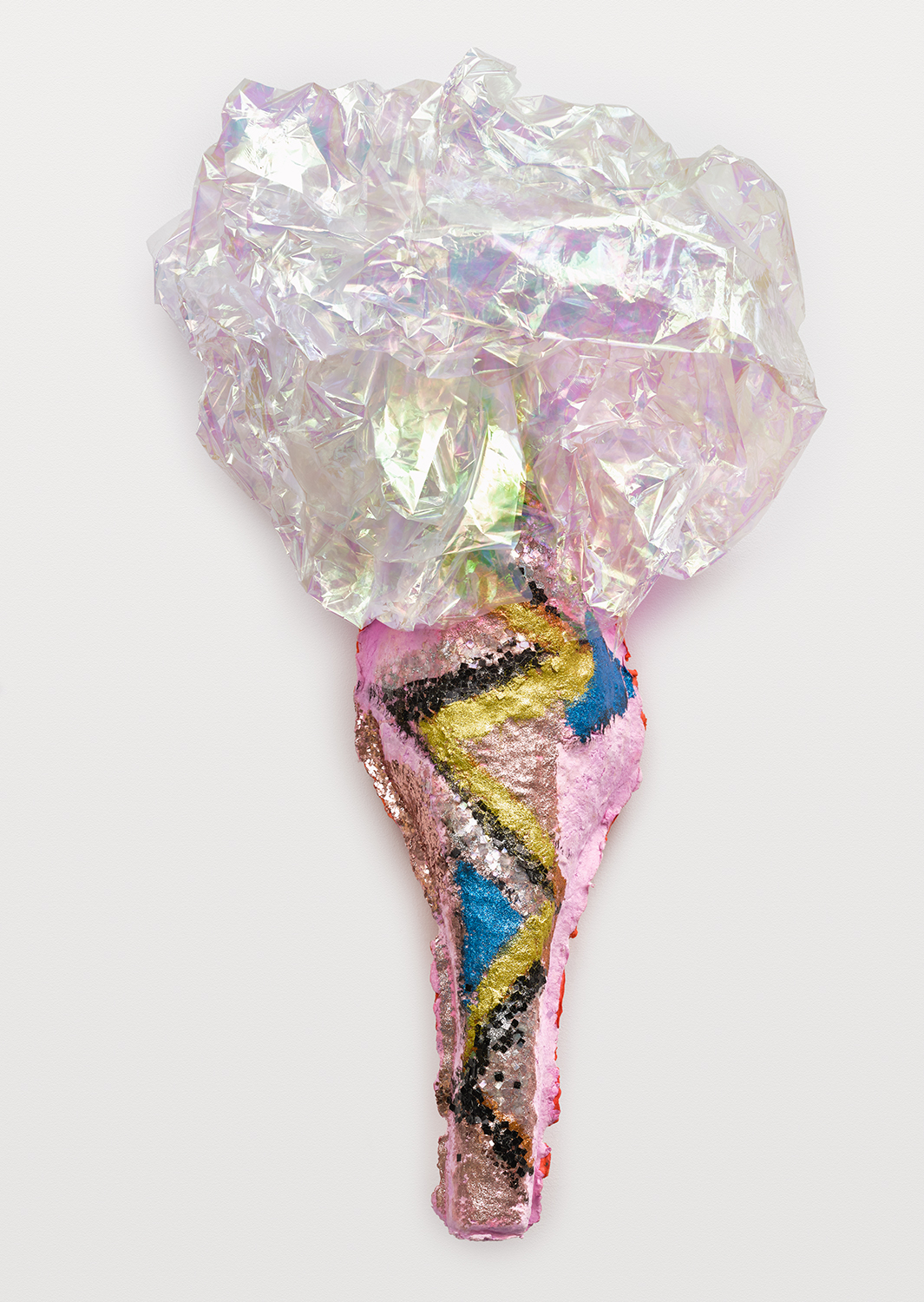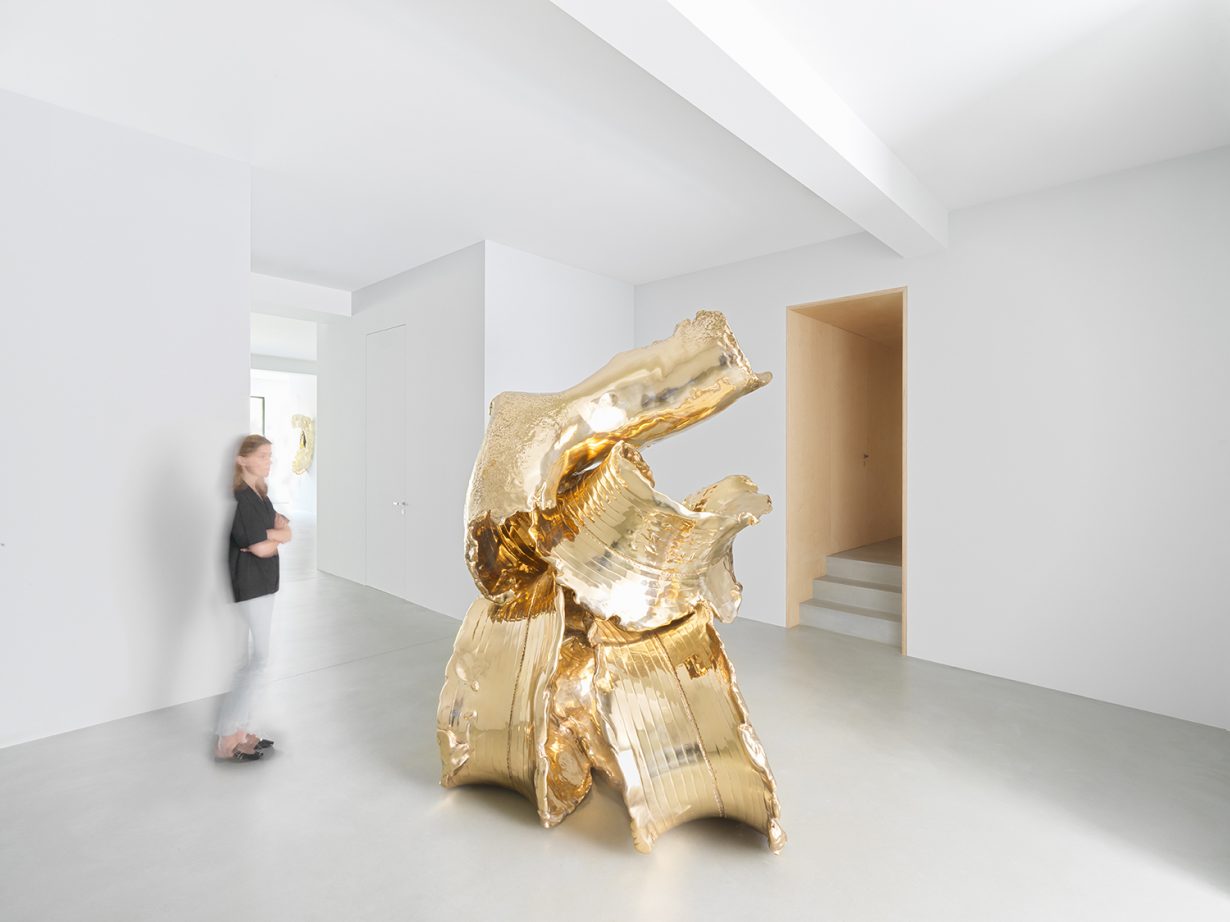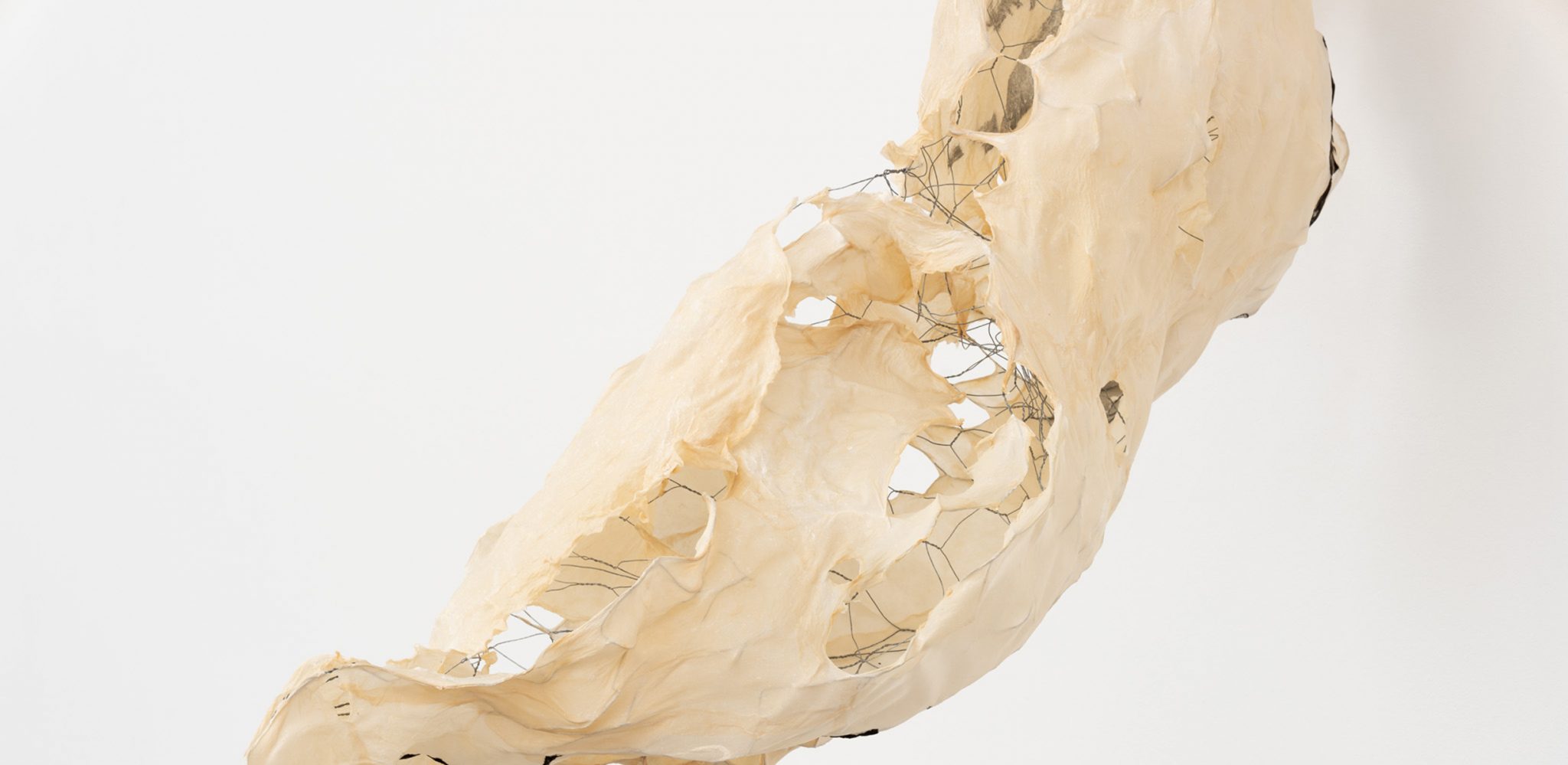Flesh and the body are never far from mind in the artist’s new sculptures
As far as Lynda Benglis is concerned, her work is always about transformation. During a long phone conversation one evening, we talked about her recent work, interspersed with long segues into her childhood memories and family history, and the ongoing importance of each to her work today. Her beloved long-haired dachshund, Cleo, was present for much of the conversation, when he wasn’t playing hide and seek, and we talked at length about her life as an artist living in New Mexico (she is an accomplished adobe builder). When we finally moved on to the topic of her most recent work, Benglis spoke with candour about her relationship to materials and working process. She wants, she said, to give abstract ideas form, watching the object take shape, from raw material to final form (every work starts, she told me, with daydreaming). The American artist’s latest exhibition (she turns eighty this year), at Xavier Hufkens in Brussels, features the recent body of paper-and-chicken-wire sculptures she has been making since 2013, alongside an enormous abstract bronze sculpture, Power Tower (2019). The exhibition’s title, Nœuds et nus (knots and nudes), playfully combines the artist’s long-term commitment to the abstract-erotic rendering of form and flesh, while the pieces on show look back to the artist’s earlier work in latex, muslin, aluminium, gesso and beeswax from the 1970s, although their delicate paper carapaces introduce a sense of precariousness and fragility that was absent in her earlier works. Wire and paper pieces, including House of Cards (2016), Odalisque (2016) and Queen Bee (2016), are mounted on the gallery wall in what the critic Robert Pincus-Witten described as ‘frozen gestures’, capturing that sense of the work being in a state of becoming, mid-melt or -pour, in a series of gestures frozen in space and time.

Benglis’s place in art history was secured by an infamous double-page advertisement she created and published in Artforum magazine in November 1974. Benglis posed for the camera, her naked, oil-slicked body thrusting provocatively towards the camera as she grasped a giant double-ended dildo between her legs. It was a witty riposte to the machismo then dominating the New York artworld, although not everyone took it in that spirit. The spread was accompanied by an article written by Pincus-Witten, which, alongside reproductions of Benglis’s latex, wax, video, sparkle-knot and poured-foam sculptures, included another full-page photograph of the naked artist, jeans pooled around her ankle boots as she glances coquettishly back at the camera of Annie Leibovitz. This photograph was also used as the announcement for her May 1974 exhibition at Paula Cooper Gallery, New York. The subsequent furore over the publication of these photographs split critical opinion. While many saw it as a brilliantly bold act of feminist subversion, Artforum published a letter by five of its current editors distancing themselves from the magazine’s decision to publish images of such ‘extreme vulgarity’ that, they argued, made a ‘shabby mockery’ of the gains of the women’s movement (Annette Michelson and Rosalind Krauss were two of the signatories).
The erotics of artmaking were never far from Benglis’s mind. During the late 1960s she began to work with liquid latex rubber, adding coloured pigment to buckets of latex before pouring it directly into puddles on the floor, where it would dry and set (Benglis liked how the finished work could be rolled up and carried). A group of photographs published by Life magazine of Benglis mid-pour recalled the series of images of Jackson Pollock at work, unstretched canvas on the floor at his feet as he poured paint directly from the can. These photographs filled the frontpage of an article titled ‘Fling, Dribble and Dip’ (27 February 1970), which reported on the current turn towards poured ‘antiform’ sculpture (Richard Serra’s molten metalworks were featured on the next page). Critics including the author of the Life article were quick to compare Benglis’s work to the gestural markmaking of her abstract-expressionist predecessors, something the artist acknowledged with one of her earliest floor pours, Odalisque (Hey, Hey Frankenthaler) (1969), subtitled after the painter Helen Frankenthaler. Benglis recalls the modernist critic and chief proponent of abstract-expressionist painting, Clement Greenberg, scratching his head in front of one of her floor pieces, unsure what to make of such a literal translation of the abstract-expressionist gestural painting process.

Around the same time that she began to work on the pours, Benglis started to make long stippled lozenges from pigmented beeswax applied to Masonite panel. By the early 1970s she was making knotted wall pieces from aluminium tubes of wire mesh covered in cotton bunting and plaster that she then tied and decorated (in 1973 she began to spray the knots with vaporised metals such as aluminium, copper and tin). Benglis also embarked upon an intense period of working in video, in line with many other artists, notably other women, in which the erotics of the moving image and politics of representation took centre stage. Now (1973), a 12-minute video in which the artist appears to interact with an image of herself, speaking commands such as “Now” and “Press record”, explores questions of coercion and control, while Female Sensibility from the same year features closeup shots of Benglis and another woman kissing and caressing each other.

Several critics have described Benglis’s love of excess as decidedly camp, noting the delight she takes in muddling ‘high’ and ‘low’ cultural references through the addition of garish sparkles and glitter to her work. Benglis though is quick to make connections to her childhood in many of these works, from the extravagance of the carnival colours she experienced as a child in New Orleans to her family’s Greek heritage and her adolescent love of Hollywood and rock and roll. A childhood memory of a particular colour or shape often provides the basis for her current work, as much as the colour charts and car paint swatches she would later discover in art supply stores as a student. She sees the ‘pompadour’ roll of hair sported by a glamorous childhood teacher in her undulating forms, while another vivid memory is the acid-bright peel of a juicy orange she remembers her mother feeding her as a baby. Whatever the specific reference, for Benglis flesh and the body are never far from mind, and despite the abstraction of her works she sees them as intimately related to skin and flesh, enjoying the erotic potential and tactility of her chosen materials and their ability to seduce and invite the viewer in.
Benglis herself describes the paper and wire sculptures that feature in the current show in insistently bodily terms, preferring ‘skeleton’ and ‘skin’ to ‘surface’ and ‘structure’. Flesh, not form, is her preferred vocabulary when talking about her sculpture (she describes the recent paper pieces as “porous, like skin”). Power Tower is an enlargement of the Elephant Necklace group of glazed ceramic curls that Benglis previously made by hand (she has also worked extensively with sand-cast glass, tying knots before the glass hardens from its molten state). Weighing over a ton and standing over two metres tall, Power Tower sits squat on the floor, as though crumpled under its own weight. The surface of this giant bronze knot, polished to an intense sheen, appears as though in a state of flux, delicate and smooth in some places, while in others the metal is pleated in a tight shiny concertina curve (the artist has compared it to a blown-out tire). This monumental frozen gesture has Barbara Hepworth-like holes that punctuate the form and encourage the viewer to keep mobile, as each step reveals a different and surprising perspective.

Benglis told me that the paper and chicken-wire sculptures are about “interior space and their relationship to the wall”. Studding the gallery walls, they look like bleached-out bones or driftwood, their desiccated whiteish surfaces only occasionally interrupted by splashes of colour and glitter. As they project from the wall in twisted shelllike forms, they turn and torque to reveal their chicken-wire interiors. Benglis first began to work with handmade paper in 1978, although it wasn’t until 2012 she started to leave the wire support in place, having previously removed it once the paper dried. She moulds the small, wet squares of cotton paper around wire armatures and leaves to harden. The paper is pressed onto the wire framework, the diamond shape of the wire twists imprinting the paper as though a dried-out snakeskin sheath. Benglis likens the wet paper mix to clay and must work quickly before the wet fleshy squares start to turn and go mouldy. Once she starts, the artist can spend up to eight hours standing in her Santa Fe studio and applying the sheets of wet paper to the chicken-wire structures before leaving them to slowly dry in the arid New Mexican heat, aided by giant fans.
From the start of her career the move from soft, pliable material to hardened final form has had an air of the magical to it. Art, she says, “is an intellectual and an emotional thing”. It is this kind of approach to artmaking that set Benglis apart from her minimalist and conceptual contemporaries, aligning her practice more with her expressionist forebears and feminist peers, and which has in turn made her work hard for critics to situate since the 1960s. It is easy to see this kind of back and forth between thought and feeling, between abstract concept and the materiality of the handmade, in Benglis’s recent works in bronze and paper that tread a fine line between the monumental and the fragile in their abstract invocations of skin and skeleton, and the fleshy limits and possibilities of her abstract bodily forms.
Lynda Benglis: Noeuds et nus is at Xavier Hufkens, Brussels, until 16 October
Jo Applin is professor of modern and contemporary art at the Courtauld Institute of Art, London
